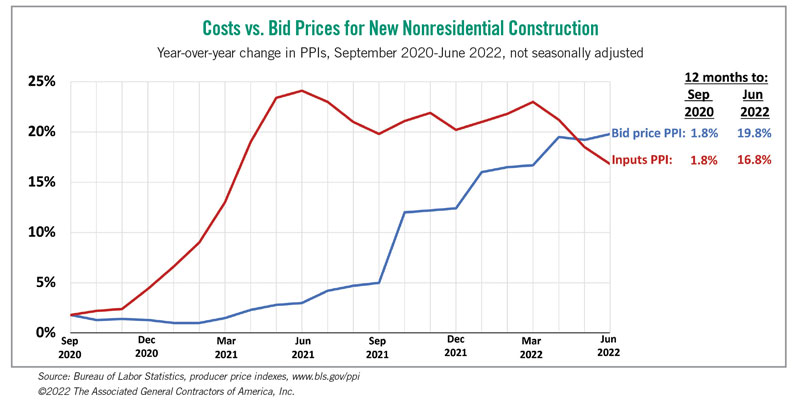Contractors Share the Pain of Rising Costs

Higher prices for materials and services are being passed on to developers.
After nearly two years of swallowing ever-rising materials costs, construction contractors are now passing them along in bid prices. Developers may be facing a prolonged period of high construction costs at the same time that financing costs are also escalating.
Each month, the Bureau of Labor Statistics (BLS) posts producer price indexes (PPIs) for thousands of materials and services, including one for inputs to new nonresidential construction. The index is a weighted average of all materials and services, such as trucking and design services, used in nonresidential building.
BLS also puts together a “bid price” PPI for new nonresidential building construction by asking a fixed group of contractors what they would charge to erect a particular building. Each respondent is asked about the same building it previously provided an estimate for. Contractors are asked to report what they would charge to cover overhead and profits. BLS combines this number with figures from a cost-estimating firm on the cost of materials, components and installation. In this way, the bid-price estimate comes close to replicating the type of price reported by a manufacturer or wholesaler for a specific commodity. The overall bid-price PPI is a weighted average of PPIs for new warehouse, office, school, industrial (manufacturing) and health care buildings.
As the figure below shows, the PPIs for inputs and bids each rose just 1.8% from September 2019 to September 2020. From then on, the input PPI accelerated steadily, topping out at a 24.1% annual rate of increase in June 2021. By April 2022, the index had risen at an annual rate of 20% or more for 12 consecutive months.

Meanwhile, the bid-price index barely budged, continuing to rise at an annual rate of only 3% or less until the spring of 2021. At that point, bids began accelerating as increasing workloads enabled contractors to become more insistent on passing through their higher costs and as talk of inflation being “transitory” faded.
By May 2022, the runup in input costs finally moderated to a year-over-year rate of “only” 16.8%. At the same time, the bid-price index rose to a 19.8% annual increase.
Although the year-over-year change in input costs has finally moderated somewhat, developers should not assume that further relief is imminent. The index climbed 1.1% from May to June. That outpaced the 0.5% increase in the bid-price index that month, suggesting that contractors are still experiencing cost increases that they have yet to pass along.
In fact, a comparison of the year-over-year change in the two types of indexes shows that once contractors “catch up” with past input cost increases, bid prices typically outrun input costs for an extended period. The PPI for goods and services inputs to nonresidential construction dates back only to 2014, but a similar index — the PPI for goods alone — was introduced in 2010, allowing for a longer period of comparison.

The cost of goods — materials and items consumed in construction such as fuel — increased more than bid prices on a year-over-year basis for nine consecutive months, from June 2011 through February 2012. Then bid prices climbed more rapidly than costs for the next seven months. Similarly, cost increases topped bid-price increases for 15 months from September 2017 through November 2018 before the situation reversed for the following 24 months.
This historical record does not guarantee that contractors will again push up bid prices faster than input costs, and it does not say how soon such a change will occur, if at all. But clearly, contractors cannot absorb rising costs indefinitely. Developers and investors should not be surprised if that reversal occurs soon, given the long period of squeezed margins that contractors have already experienced.
Ken Simonson is the chief economist with the Associated General Contractors of America. He can be reached at ken.simonson@agc.org.






